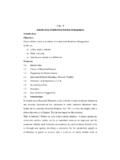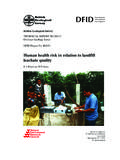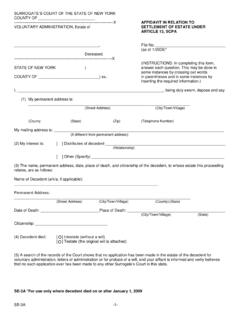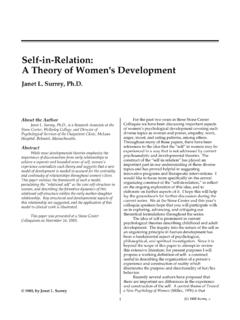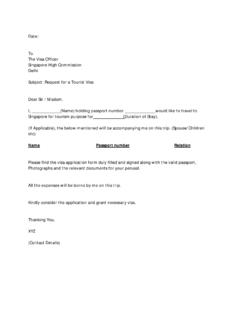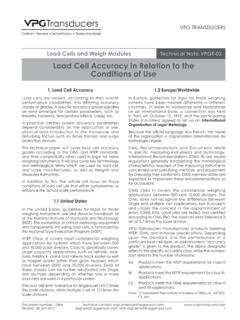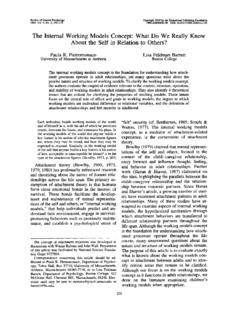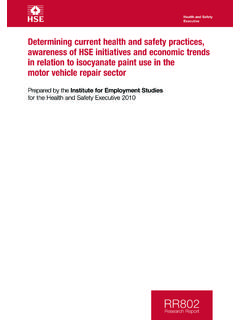Transcription of [Title]: Traditional Ecological Knowledge - Silva For
1 Traditional Ecological Knowledge by Deborah McGregor (Article originally published in Ideas: the Arts and Science Review, vol. 3, no. 1, spring 2006, Faculty of Arts & Science, University of Toronto When I was invited to write this article on Aboriginal Traditional Ecological Knowledge (TEK, otherwise known as Indigenous Knowledge ), I found myself thinking that the opportunity and timing were ideal. As an Anishnabe woman and professor of geography and Aboriginal studies, the topic has occupied my attention daily, on both professional and personal levels, for much of my life. TEK, moreover, is a field that, in recent years, has expanded rapidly and is becoming ever more central to resource management activities aimed at achieving the long-term sustainability of our planet.)
2 To begin, then, I will follow Anishnabe tradition by situating myself in relation to this topic and introducing readers to the perspective I hold. I grew up in a First Nation community in northern Ontario. For much of that time, we had no electricity or running water, and my family depended heavily upon their direct relationship with the land and water to survive (they still do in many ways). Long before I learned anything about TEK as a scholarly concept, I was learning its central principles, ethics, and values informally, simply as a part of growing up. I have been fortunate to have had people in my family and community who have worked hard and sometimes in secret to keep our traditions alive.
3 No one called the principles by which we lived TEK and they probably would have been amused if the idea had been presented to them. A far cry from the somewhat idealized descriptions bandied about in academic discussions, actually living and learning TEK was not at all glamorous mostly just hard work. Later, as a student and then professor, my approach to and understanding of TEK developed into something entirely different. I now teach a course on Indigenous TEK and I incorporate its principles into my other courses as well. I am also an environmental professional, often employed by Aboriginal organizations in Ontario. Thus, it is a routine part of my work to educate people about, and create awareness of, TEK and its importance for environmental sustainability.
4 What, then, is TEK? Well, depending on whom you ask, you will get a different response. Some Aboriginal scholars, such as Marie Battiste (Micmaq) and James Henderson (Cherokee), argue that it cannot and should not be defined as definitions of TEK vary from Nation to Nation and from individual to individual; reducing this diversity to more universal definitions, it is believed, is a first step in the Eurocentric process of separating TEK from its intended context. Others point out that TEK has been defined largely by non-Aboriginal academics, and that Aboriginal perspectives are conspicuously absent in the literature (a situation that is changing, slowly). Some practitioners, like Henry Lickers (Seneca from Six Nations of the Grand River and Director of Environment for the Mohawks of Akwesasne), reject the term altogether and substitute their own.
5 A growing trend, then, is for Aboriginal people to generate their own definitions, and to use TEK as a label only in certain situations. In All Our Relations: Native Struggles for Land and Life (1999), Anishnabe environmental activist Winona LaDuke, for example, refers to Minobimaatisiiwin, which means the good life and which involves concepts of revival, rebirth, and renewal. Existing in spite of colossal injustices, both past and present, Minobimaatisiiwin, which comes from the Creator, is the lifeway that has sustained, and will continue to sustain, Anishnabe nations. A critical point in LaDuke s book is that, in order to understand Minobimaatisiiwin, and in order for the Aboriginal Knowledge inherent in this way of life to have any real meaning, you must live it: if you are not living the good life, you are not learning or practising TEK.
6 Despite ongoing debate over its definition, TEK continues to gain importance in considerations of environmental sustainability. In 1987, the World Commission on Environment and Development released Our Common Future ( the Brundtland Report, after the Commission s Chair, former Norwegian Prime Minister Gro Harlem Brundtland). This landmark document, which was toted around like a bible by environmental studies students for years afterwards, not only introduced the concept of sustainable development to mainstream discourse, but also provided international recognition of the potentially vital contribution to be made by Aboriginal people to the resolution of global environmental issues.
7 This seems straightforward enough now, but back then it represented a significant shift in the discourse on Indigenous peoples and the environment from the representation of Indigenous peoples as problems to be solved and/or victims to be rescued, to the positive contribution that they can make to global sustainability by virtue of their millennia of experience in living sustainably on the land. Five years later, at the United Nations Conference on Environment and Development (the Earth Summit in Rio de Janeiro), the legally-binding Convention on Biodiversity (CBD) was signed. The CBD reiterated the critical role of Indigenous people and their Knowledge for achieving sustainable environmental and resource management.
8 This notion has been reinforced in numerous venues since then, including in public arenas, where journals, such as the American Indian Quarterly (28[3/4]: 2004), have devoted entire issues to the topic. Canada also has responded to the challenges brought forth by both the Brundtland report and the CBD and is attempting to incorporate TEK into various environmental decision-making processes, such as a growing body of Canadian environmental legislation that includes the Canadian Environmental Assessment Act, the Canadian Environmental Protection Act, and the Species at Risk Act. The field of TEK, thus, is well on its way to becoming firmly entrenched in the theory and practice of environmental management in Canada, particularly in the North, where it is already part of routine public policy.
9 TEK is viewed now as presenting viable alternatives to the status quo, which is seen to have caused today s environmental problems in the first place. Realizing the limits of its own systems and, in turn, recognizing the potential value of Indigenous Knowledge for addressing global environmental concerns is a significant step for Western society, and one that is certainly still not all-pervasive. Nonetheless, many environmental professionals believe that science and technology, at least on their own, cannot extricate us from our current crises. Other approaches are desperately needed and, thus, it is perhaps only logical that TEK has come to be viewed as a current, relevant, and viable system for understanding the situation and providing a basis from which to work toward solutions.
10 These days, anyone who is truly interested in sustainable development should also be interested in TEK. Anishnabe Perspectives on the Environment and TEK Just as there is global diversity in culture, so is there diversity in TEK, according to cultural group, local tradition, landscape, and social values. To understand Anishnabe perspectives on the environment, you must start with the Anishnabe Aboriginal Creation and Re-Creation stories, which, as stories that inform us of our beginnings, provide the conceptual frameworks for an Indigenous understanding of our relationship to our environment. Like TEK, these stories have different versions that vary with the storyteller or with local cultural traditions.
